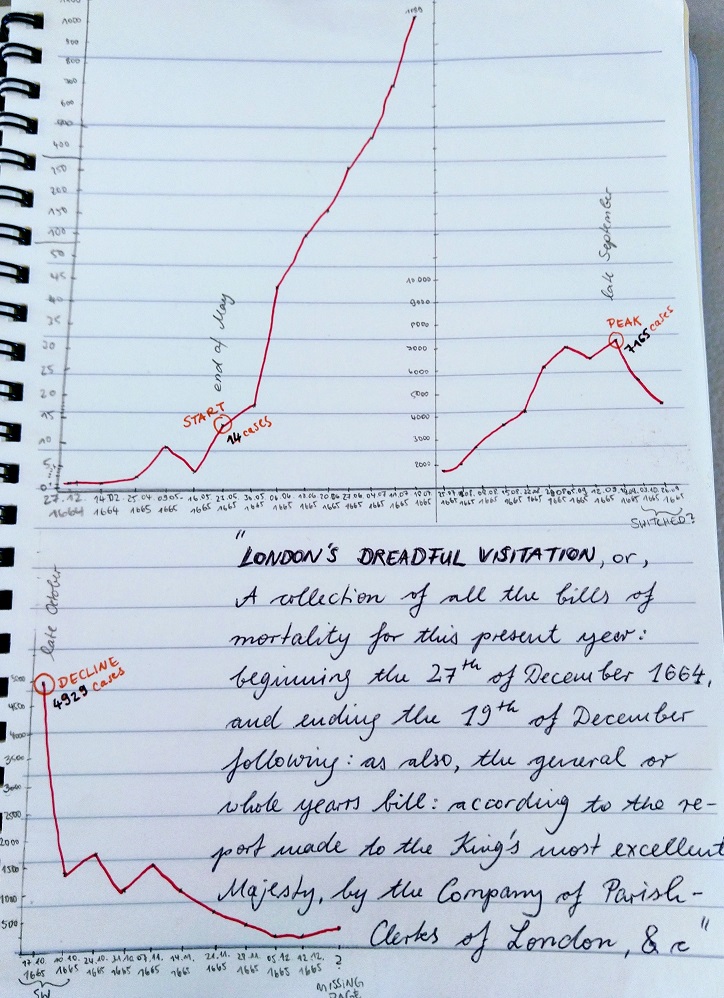London's Dreadful Visitation or the Bill of Mortality from 1664-65
Something a bit different. In light of the current pandemic, I thought it would be interesting to review how pandemics were progressing and recorded in olden times. This is concerning the Great Plague of London in 1665, cause by a bacterium, Yersinia pestis.
The data in the Bill of Mortality of this time covers causes of death from the 27th of December 1664 to the 19th of December 1665.

This is a simplistic diagram on the progression of plague death between the 27.12.1664 to the 19.12.1665. While there is a tiny cluster in early May, it is on the 23. May 1665 that the cases steadily increase. On this date, there are 14 deaths. Bubonic Plague has an incubation time of 2 to 6 days.
The second part of the diagram shows the peak as it was recorded here, with 7165 deaths in late September 1665. By late October, there’s a recline, with 4929 deaths recorded.
Actual Numbers
Problematically, these are most certainly not the real numbers of death at the time. Reasons are plentiful:
- people did not die in hospitals, but at home
- there was no law forcing anyone to report a death
- death counts were overseen by ‘Searchers for the Dead’, who, for a nominal fee, went out and checked on people, judging what they might have died of. This was a dangerous,badly paid, and stigmatising job and thus usually done by elderly women without any medical knowledge
- searchers often depended on the local sexton for their reports, thus non-Anglican Christians or Jews were rarely counted
- households did not want to be known to have plague deaths, both for the stigma and the threat to their lives (houses with plague victims were locked up for 40 days, with all occupants inside), and could easily bribe the searchers to change the cause of death to something more respectable
- misdiagnoses and bribery saw other illnesses mysteriously skyrocket, most notably ‘Feaver’ and ‘Consumption’
It must be assumed that the real number of deaths during this time is around 100.000.
All Other Causes of Death in London’s Dreadful Visitation
(and a quick explanation of the most curious ones)
Abortive = Miscarriage
Aged
Ague = Malaria
Apoplexie = Stroke
Bedridden
Blasted
Bleeding
Bloody Flux = Dysentry
Broken Legge
Bruised
Calenture = Heatstroke
Cancer
Canker
Childbed
Chrisomes = Child dead in its first month of life
Cold
Collick
Consumption = Tuberculosis
Convulsions
Cough
Distracted = Perhaps senility?
Dropsie = Edema
Executed
Feaver
Fistula
Flox and Small-pox
French-pox = Syphilis
Frighted
Gangrene
Gowt = Gout
Grief
Griping in the Guts = Abdominal Cramps
Headache
Head-Mould-Shot = Craniosynostosis (crushed soft plate in newborns)
Jaundice/Jaundies
Imposthume = Abscess (filled with pus)
Infants = Yet unable to Speak
Barking
Kingsevil = Scrufola (Tuberculosis of the Neck
Lethargy
Livergrown = Enlarged Liver
Meagrome = Migraine
Measles
Mother = Childbed Fever?
Mouldfallen = Craniosynostosis (crushed soft plate in newborns)
Overlaid = Crushed (likely a baby by an adult)
Palsie = Paralysis
Plannet = Death by misaligned Planets
Plurisie = Inflammation of the Lungs
Purples = Blood underneath the Skin
Quinsie = _uffocation by Tonsilitis
Rickets
Rising of the Lights = Croup
Rupture
Sciatica = Pain in the Hip & Back (death by treatment?)
Scowring = Diarrhea
Scurvy
Shingles
Sore Breast
Sore Legge
Sore Mouth
Sore Throat
Spleen
Spotted Feaver = Either Typhus or Meningitis
Stilborn
Strangury = Inability to Urinate (symptom for UTI’s or Kidney Issues)
Stone
Stopping of the Stomach = Tenesmus (inability to vacate bowels)
Suddenly = Better than Slowly?
Surfeit = Excess of - unclear what the excess was here
Teeth = Possibly death during teething in an infant
Thrush = Fungal Infection
Timpany = Bloating of the Digestive Tract
Tissick = Lung Problems (Asthma, Bronchitis, Tuberculosis)
Ulcer
Vomiting
Wen = Abnormal Growth on the Skin
Winde = Gastrointestinal Issue
Wormes
Wounded (At Sea)
